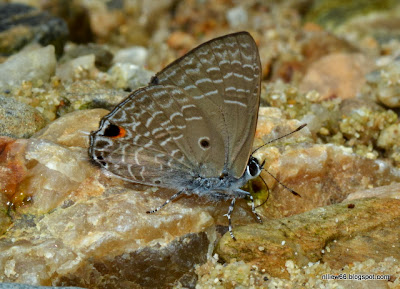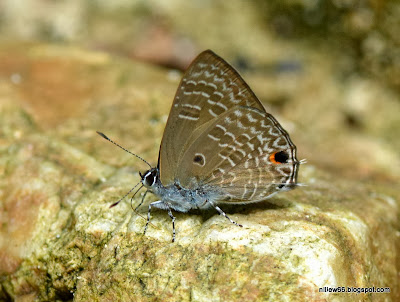This is more or less rarer than its cousin A. emolus and has a decidedly pointier forewing apex than the Common Ciliate Blue. On close observation, it can be distinguished from A. emolus by the presence of a ringed dark spot near the marginal area of its hindwing undersides, giving it a "moled" appearance. They are usually found puddling in the same vicinities on moist spots on a sunny morning.
Habitat indicator
RSP
|
WV
|
PG
|
VF
|
FTR
|
SC
|
LWDF
|
LWPF
|
LMEF
|
UMN
|
MN
|
x
|
x
|
x
|
x
|
x
|
x
|
x
|
x
|
x
|
x
|
Frequency observation chart: (S marks the usual occurences, H marks an unusually high occurence, F for first record)
2013
| |||||||
Mac
|
Apr
|
May
|
Jun
|
Jul
|
Aug
|
Sep
|
Oct
|
S
|
S
|
S
|
S
|
S
|
S
| ||
2013
|
2014
| ||||||||||
Nov
|
Dec
|
Jan
|
Feb
|
Mac
|
Apr
|
May
|
Jun
|
Jul
|
Aug
|
Sep
|
Oct
|
S
| S | H | S | S | S | S | S | S | |||
2014
|
2015
| ||||||||||||
Nov
|
Dec
|
Jan
|
Feb
|
Mac
|
Apr
|
May
|
June
|
Jul
|
Aug
|
Sep
|
Oct
|
Nov
|
Dec
|
S
|
S
|
S1
|
S1
|
S1
|
S
|
S3
| |||||||
2016
|
|||||||||||
Jan
|
Feb
|
Mac
|
Apr
|
May
|
Jun
|
Jul
|
Aug
|
Sep
|
Oct
|
Nov
|
Dec
|
S1S2
|
S1S2
|
||||||||||
2017
|
|||||||||||
Jan
|
Feb
|
Mac
|
Apr
|
May
|
Jun
|
Jul
|
Aug
|
Sep
|
Oct
|
Nov
|
Dec
|
S3
|
S2S3
|
S1S2S3
|
S1S2
|
S1
|
|||||||
13 June 2013 @ 13:20
13:28
14:03
14:09
* * * * *
At certain angle of the light, the uppersides display an incredible velvety blue sheen that must number among the most spectacular colours of Nature. 14 September 2013 @ 11:37
Above 3 photos 14 September 2013 @ 11:34










No comments:
Post a Comment